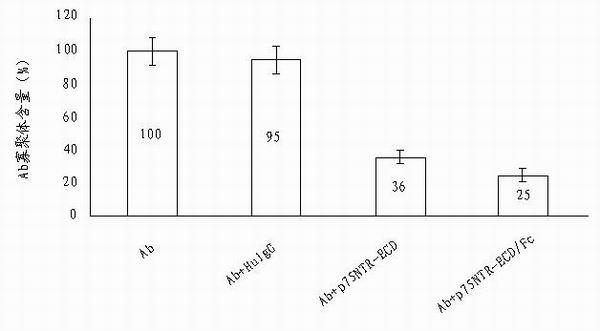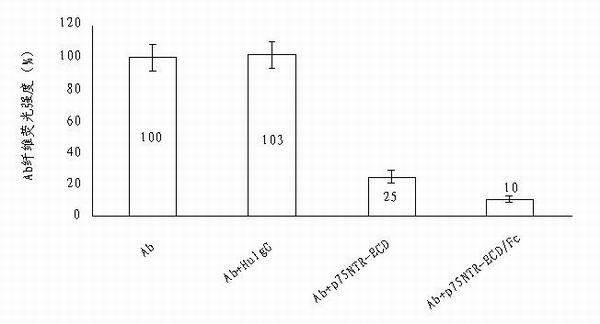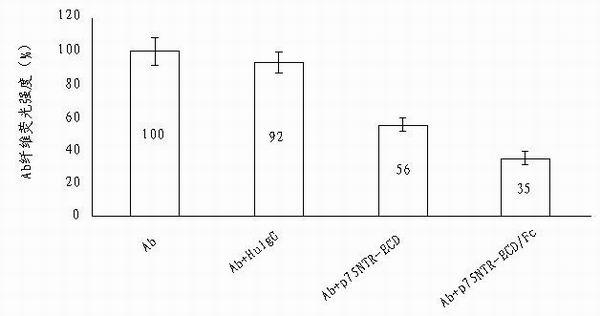Use of p75neurotrophin receptor-extracellular domain (p75NTR-ECD) in medicine for preventing and treating Alzheimer disease
A technology of Alzheimer's disease and p75ntr-ecd, which is applied in the field of biomedicine to achieve the effect of broad clinical application prospects
- Summary
- Abstract
- Description
- Claims
- Application Information
AI Technical Summary
Problems solved by technology
Method used
Image
Examples
experiment example 1
[0047] Experimental example 1: p75NTR-ECD and p75NTR-ECD / Fc inhibit Aβ42 oligomer formation
[0048] Mix 2.5 μg Aβ42 (final concentration 20 mM) with p75NTR-ECD / Fc (final concentration 10 mM), p75NTR-ECD (final concentration 10 mM) or human IgG (hereinafter referred to as HuIgG, final concentration 10 mM), 4 oC for 1 day. The same amount of Aβ42 (final concentration: 20 mM) was not incubated, or the same amount of Aβ42 (final concentration: 20 mM) was incubated alone at 4 oC as a control. Then perform protein electrophoresis, and use 6E10-biotin antibody for western blot detection to determine the content of Aβ42 oligomer bands.
[0049] Such as figure 1 As shown, compared with the Aβ42 single incubation group (Ab) (for the convenience of comparison, the Aβ42 oligomer content of this group is taken as 100%), the Aβ42 oligomer content of the HuIgG and Aβ42 co-incubation group (Ab+HuIgG) was 78 %, Aβ42 oligomer content of Aβ42 and p75NTR-ECD co-incubation group (Ab+p75NTR-EC...
experiment example 2
[0050] Experimental example 2: p75NTR-ECD and p75NTR-ECD / Fc inhibit Aβ42 fibril formation
[0051] Mix 2.5 μg Aβ42 (final concentration 20 mM) with p75NTR-ECD / Fc (final concentration 10 mM), p75NTR-ECD (final concentration 10 mM) or HuIgG (final concentration 10 mM), and incubate at 37 oC for 4 days. The same amount of Aβ42 (final concentration of 20 mM) was not incubated, or the same amount of Aβ42 (final concentration of 20 mM) was incubated alone at 37 oC as a control. Then add Thioflavine T to detect the fluorescence intensity (excitation wavelength 450nm, emission wavelength 482nm). The higher the fluorescence intensity, the more Aβ fibers.
[0052] Such as figure 2 As shown, compared with the Aβ single incubation group (Ab) (for convenience of comparison, the fluorescence intensity of this group is taken as 100%), the fluorescence intensity of the HuIgG and Aβ co-incubation group (Ab+HuIgG) is 103%, and the Aβ42 and p75NTR-ECD The fluorescence intensity of co-incubat...
experiment example 3
[0053] Experimental example 3: p75NTR-ECD and p75NTR-ECD / Fc promote the depolymerization of Aβ42 fibers
[0054] Firstly, 2.5 μg Aβ42 was dissolved in DMEM (final concentration 20 mM) and incubated at 37 oC for 4 days to form Aβ42 fibers. The formed Aβ42 fibers were mixed with p75NTR-ECD (final concentration 10 μM), p75NTR-ECD / Fc (final concentration 10 μM) or HuIgG (final concentration 10 μM), and incubated at 37 oC for 3 days. Then add Thioflavine T to detect the fluorescence intensity (excitation wavelength 450nm, emission wavelength 482nm). The higher the fluorescence intensity, the more Aβ fibers.
[0055] Such as image 3 As shown, the results show that compared with the Aβ fiber incubation group (Ab) alone (for convenience of comparison, this group of fluorescence is taken as 100%), the fluorescence intensity of the Aβ fiber co-incubation group with p75NTR-ECD (Ab+p75NTR-ECD) is 56 %, the fluorescence intensity of Aβ fibers incubated with p75NTR-ECD / Fc group (Ab+p75N...
PUM
 Login to View More
Login to View More Abstract
Description
Claims
Application Information
 Login to View More
Login to View More - R&D
- Intellectual Property
- Life Sciences
- Materials
- Tech Scout
- Unparalleled Data Quality
- Higher Quality Content
- 60% Fewer Hallucinations
Browse by: Latest US Patents, China's latest patents, Technical Efficacy Thesaurus, Application Domain, Technology Topic, Popular Technical Reports.
© 2025 PatSnap. All rights reserved.Legal|Privacy policy|Modern Slavery Act Transparency Statement|Sitemap|About US| Contact US: help@patsnap.com



